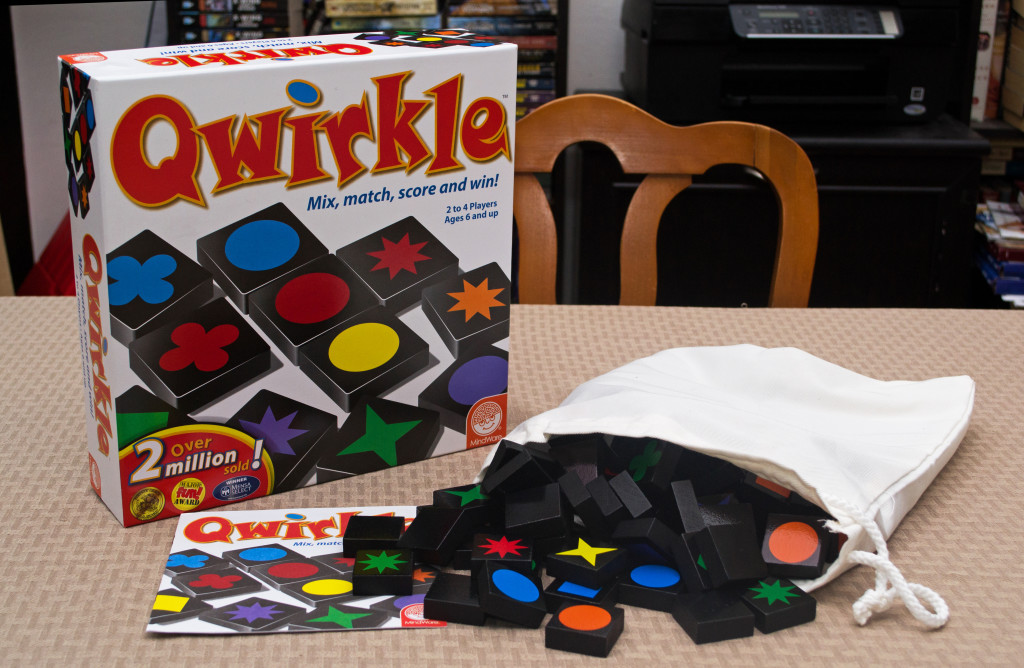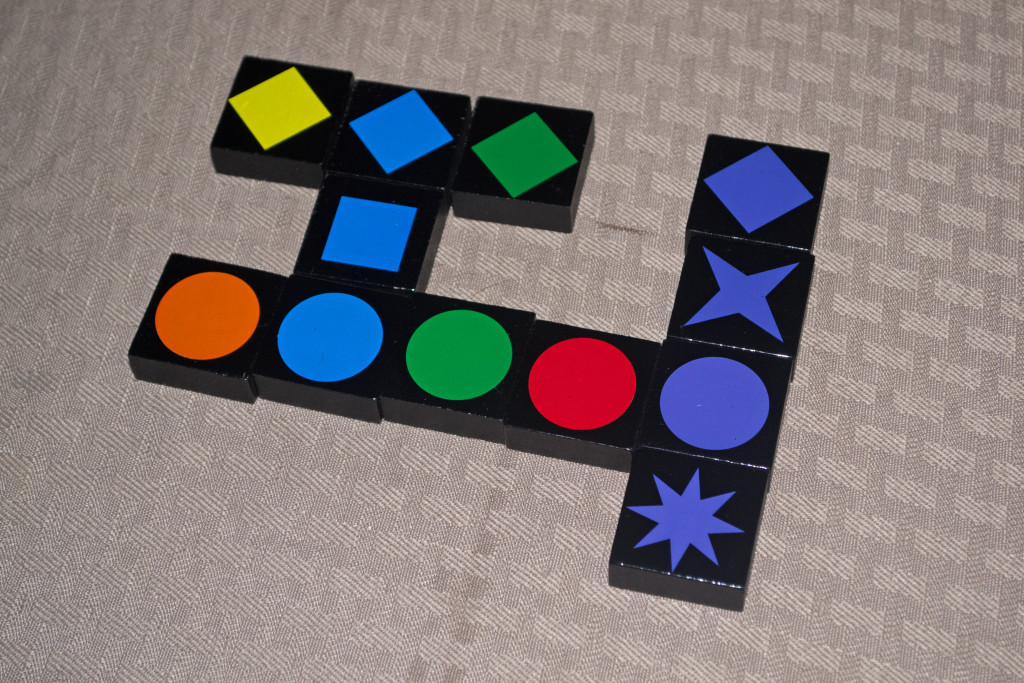It’s easy to look at the box cover of this game and think, “Whoa, look at all of those colors and shapes…it looks complicated!” In reality, it’s not…though it will make you think a bit. “Qwirkle” is a game about matching colors and shapes, but not both at the same time. One row or column might contain tiles of different shapes that have the same color, for example, while another might contain tiles of the same shape but have different colors. It won a number of different awards and seems to be fairly popular, so I figured I’d splurge a little and pick this up for the family. To that end, let’s take a brief look at the components and the gameplay before heading into the review.
*Editor’s Note: You can shorten the game’s length by removing some/half of the tiles from the game at random during setup.
Components
108 wooden tiles and a cloth drawstring bag. Each tile has an illustration on the back (circle, eight-point star, four-point star, square, clover, or diamond). Each of these symbols appears in six different colors (red, yellow, orange, green, blue, and purple).
You will need a paper and pencil (not included) to keep score.
Setup & Gameplay
All of the tiles are placed into the cloth bag and shuffled around. Each player receives six to form their starting hand, which is hidden from other players. Whoever has the most shapes of the same type or color of the same type (players will announce this) will be the starting player.
On a player’s turn, they’ll do one of two things:
1. Add one or more tiles to the grid, then draw back up to six tiles. All tiles played must share the same attribute (same color/same shape) and must be played on the same line that share the same characteristics, though they don’t have to touch. Shapes of the same color cannot repeat on the same line. If a player wanted to add a blue eight-point star and a blue four-point star to a line containing a blue diamond and blue clover, for example, they’d be allowed because none of the shapes repeat. Likewise, a color cannot repeat on a line where the shapes are the same.
2. Trade some or all of the tiles in your hand for new ones. After drawing new ones, the old tiles are shuffled back into the bag.
The player then earns points for each tile in the line. If a player adds two tiles to an existing row of three tiles, for example, they’d earn five points. Sometimes players will be able to play a tile that can be scored across two lines…in this case, each line is scored separately (like “Scrabble”). A player earns an additional six points for completing a line of six (called a “Qwirkle”).
The game ends when someone’s hand runs out of tiles (that person gets an additional six point bonus). Players then tally their points and whoever has the most, wins!
Editor’s Note: The above doesn’t cover all of the rules found in the manual, but should give you an idea as to how the game is played.
The Review
Firstly, let’s get the few complaints I have out of the way. Some of the colors tend to blend together, like red and orange. While there aren’t that many alternate colors to choose from, I do feel that different shades would have worked better. It’s not a game-breaker, but you may sometimes experience eye-strain if a source of light is hitting the tiles in just the wrong way. Colorblind folks may also have issues playing this game. I personally would have had each tile etched with a small “R”, “O”, “Y”, “G, “B”, or “P” so that affected players could determine which color they were looking at.
Color issues aside, this game is fantastic. The pieces are fairly hefty and the bag is most certainly large enough to handle all the tiles. I did remove the box inserts to make the game easier to put away. The gameplay is simplistic but encourages strategic play and critical thinking. Players might earn a lot of points laying down two or three tiles on their current turn, but sometimes that opens the door for someone else to finish of the line and make a “Qwirkle”. This makes the idea of playing one low-scoring tile to screw up a potential “Qwirkle” for someone else a valid one. All in all, this game is family-friendly and an easy recommend, though the colorblind should beware. So as long as others in the group are willing to help their colorblind friends out as needed, it shouldn’t be too much of an issue.
Final Verdict: 8/10
—


